Plasterboard - universal building material, which is perfect for decoration of walls in any rooms, ranging from the bathroom and ending with bedrooms and loggias. But when deciding to use it, the main thing is how to fix plasterboard and what method. Today you can use two ways: frameless, based on the use of glue, and skeleton, when the sheets should be screwed to the metallic profile.
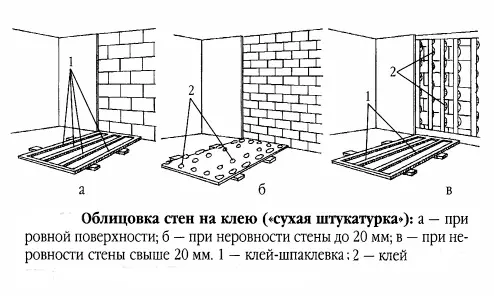
Scheme of fastening of plasterboard on glue.
Frameless fastening of plasterboard
It is not always the installation of drywall to the wall or ceiling involves the use of metal profiles as a frame, a simpler method involves the use of conventional gypsum glue, to which plasterboard sheets are stacked. But to put the sheets correctly on such technology, you will have to level the walls or ceiling or to make a complex of preparatory work. Of the benefits of lack of profiles, it should be noted:
- The strength of the base that does not appear, does not have fungus on the surface. Often, such requirements are presented with high humidity, for example, to the bathroom;
- The wall is reliably protected from dampness, does not freeze. Such a finish method is perfectly applicable to the bathroom and kitchen.
Consider in more detail the frameless method of fastening of plasterboard, which is often used to corridors, loggiam, kitchen, bathroom and toilets.
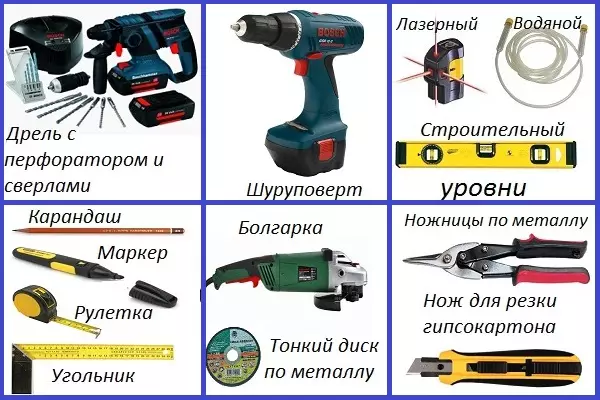
Tool for working with plasterboard.
When asking how to mount drywall, the preparation occupies an important place. Therefore, all tools and materials should be prepared immediately:
- Sheets of plasterboard (for the bathroom and kitchen it is necessary to take moisture resistant);
- Gypsum dry mix;
- Capacity for glue breeding, tools for applying it;
- laner knife;
- rule;
- Spatulas, putty;
- Construction level, fishing line;
- Roulette, simple pencil.
Stages of working with plasterboard
First, the walls are performed, markup is made on their surface to accommodate sheets. In order to correctly fasten them, it is necessary to observe a simple rule: cross-shakes are not allowed.
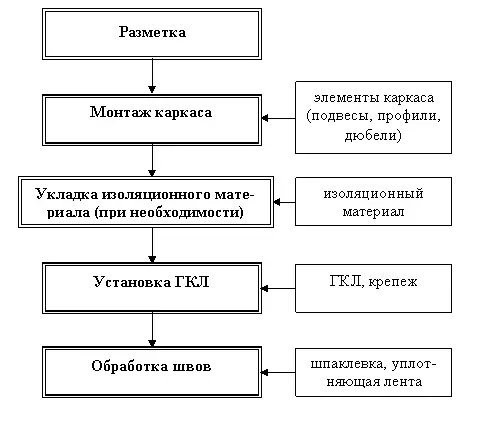
Table with step-by-step instructions for installing HCL.
The surface is cleared of dust, processed by primer. Plasterboard sheets are reproduced in accordance with the features of the room. To properly fix the GWL, it is necessary to prepare a gypsum adhesive mass. The starting spacities of slow frozen are excellent for this, often to increase the time of frozen in the mass add glue PVA, ordinary wallpaper glue.
How to mount plasterboard with glue? The mixture is applied to the toothed spatula to the surface of the sheet, after which the plasterboard is attached to the wall, observing the gaps of 5-7 mm between the plates, up to 10 mm - from the floor and up to 5 mm from the ceiling. After drying, the joints will have to be treated with putty.
Article on the topic: Plumbing with your own hands: Installation steps
Frame mounting of plasterboard
Installing the frame for drywall is applied much more often, this method is considered one of the best, providing excellent quality of work. Among the advantages of using metal profiles should be noted:
- improvement of heat and sound insulation;
- the ability to level even very curves walls and ceilings;
- Before starting work, there is no need for careful surface preparation;
- Use profile for the frame can be even for freezing walls;
- Under the frame you can carry out communication and engineering networks, put an additional layer of insulation.
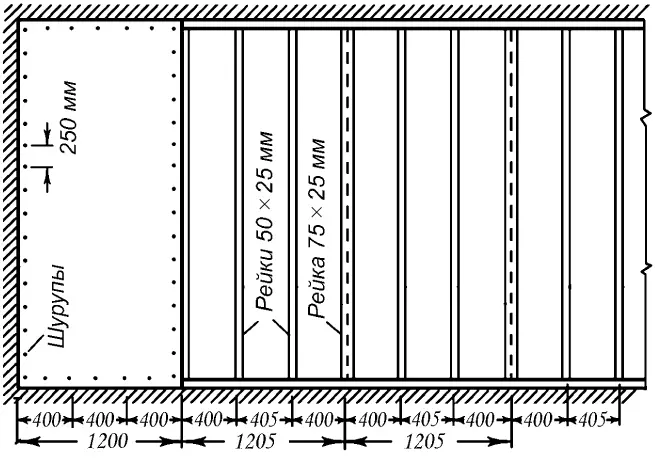
Detailed frame installation scheme.
The method itself is as follows: first the framework of metal special profiles is mounted (it is possible to use conventional wooden bars), after that the plasterboard sheets themselves are screwed to the racks.
Consider how to mount the material thus in more detail. The correct installation begins with the markings on the surface of the walls or the ceiling with a construction level, a plumb, a pencil. This allows you to determine the position of the frame, place all the places of fasteners.
The profile itself should go with a pitch of 40 cm, and the suspensions need to be put correctly with a step of 80 cm.
After installing all profiles, you can carry out engineering networks, if necessary, insulate the surface of the walls and the ceiling of mineral wool. For fastening drywall to the profile, self-tapping screws are used, all the joints of the plates should only come to the surface of the racks. When attaching such features are observed: the screws are applied with a length of 25 mm, their caps must be deepened into the material by about 1-2 mm. Under each joint necessarily the presence of support profiles that should be fixed with single-level connectors, that is, crabs.
The use of profiles as a framework allows for numerous advantages, including the lack of preparatory, expensive wall equalization.
Installation of plasterboard to the wall: detailed instructions
Most often, drywall is used to finish the walls, in which case the frame mounting method is applicable. This allows you to align the walls, make their surface perfectly smooth and ready to apply a variety of decorative coatings. We offer step-by-step instructions, how to make a frame mounting of plasterboard sheets to the wall.
Article on the topic: How to choose curtains for living room in style and color
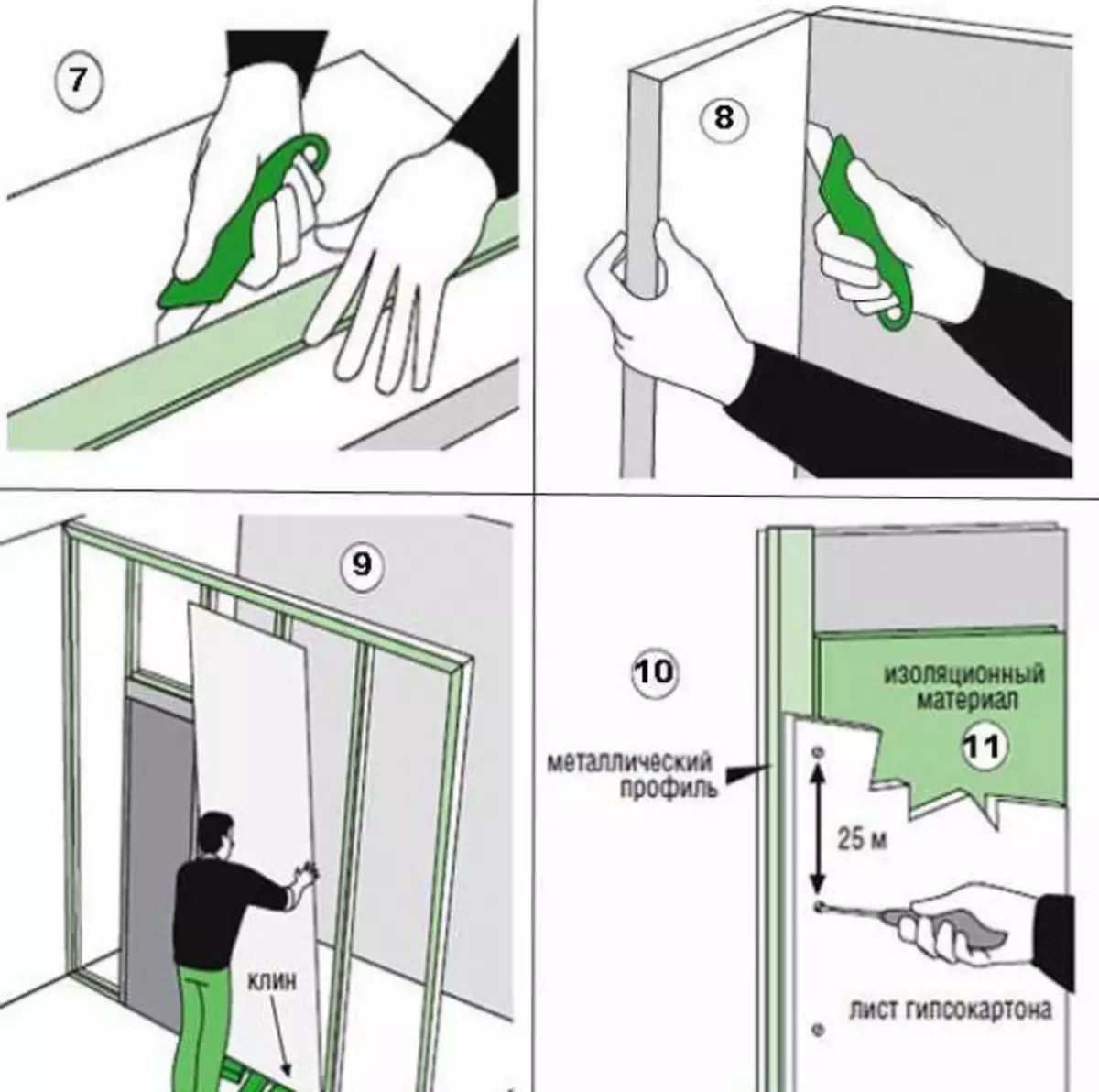
Installation of plasterboard on the wall.
- The first step is to prepare materials and tools that can be useful when working:
- Plasterboard sheets of estimated quantity and type (it can be a regular sheet, moisture-resistant for installation in the bathroom, toilet, in the kitchen and other rooms with high humidity, fire-resistant);
- Metal profile for frame (racking PS and guide PN profile) or wooden bars;
- Metal fasteners (crabs, brackets, etc.);
- Self-tapping screws for drywall and for profiles, so-called "fleas", dowels;
- putty;
- a set of crowns for plasterboard;
- Drill with a perforator;
- Construction level, plumb;
- simple pencil, roulette, assembly special glue for seals;
- Scissors for metal cutting profiles;
- hammer, joiner, spatula;
- A screwdriver (not recommended a screwdriver, even small volumes of drywall are manually not screwed).
- Applying markup for future frame. To install plasterboard correctly, you need to start the markup from the floor. We determine the distance from the wall, on which the frame will be standing, now the lower profile is put on the floor, on its external edge, we carry out a pencil. Using a construction level and a plumb, the same line is diagnosed on the ceiling. It is important that these lines completely coincide, otherwise the correct installation will be simply impossible.
- For the installation of drywall, a wooden bar can be used as a frame, but it is best to carry out installation with the help of special metal profiles with galvania. In this case, we need a rack and guide profiles.
To begin, it is necessary to take care of seals, for which it is recommended to use rubber bands glued using a special adhesive to the sole of each profile. Next, the guide profile is attached to the ceiling, for which it must be pressed to the markup, drill holes through the metal. Each of these holes should have a diameter of 6 mm and approach for fastening a dowel with dimensions 6 * 40, to fasten all the attachments.
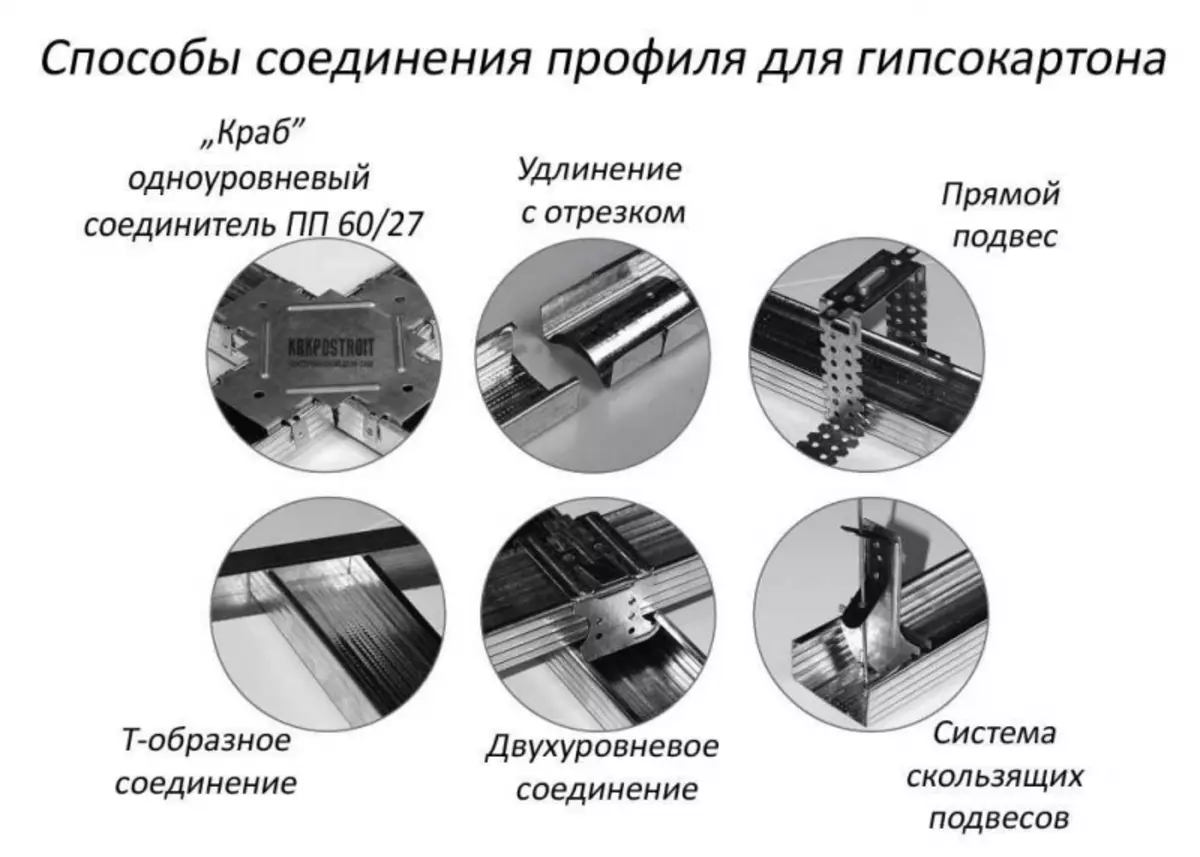
Types of fastening profile for drywall.
The vertical rack profile can be installed using self-samples or special brackets to the guide profile, which is installed on the ceiling and on the floor. Fasteners are carried out with the help of a dowel, the step of which should be from half to one meter in height.
- Laying communications, insulation. At the stage of fastening profiles, you should not forget the leakage of communication networks and the insulation, which can also perform as a sound insulator. When laying electrical cables, it is necessary to make some stock for connection points. Installation of the insulation should be made only using non-combustible materials. A mineral wool showed itself in this capacity, which has all the necessary qualities, including low weight, excellent characteristics, simplest installation.
- After the frame is ready, and the insulation and communication networks are carried out, you can use the laying of plasterboard sheets. To do this, you will have to first chop the sheets on the necessary dimensions using a joinery knife, the edges are recommended to be cleaned and adjusted. Installation in the opening area involves an additional gasket of the guides around the perimeter of the extermination itself (usually it is required near the doors, windows, niches, arched openings). The plasterboard installation is carried out in such a way that all the joints fall on the guide profiles, the screws of the screws when screwing it, it is necessary to draw a little, but not very deeply.
- Finishing work on the installation of plasterboard for the bathroom or ordinary residential room is carried out in this way. Using drill and cooked crowns, in the locations of switches, sockets and other conclusions it is necessary to prepare mounting holes. All the joints between the sheets and the places of fastening of the self-tapping screws should be covered. On this, the installation of plasterboard on the walls can be considered complete. The point is left for small: primer, putty, painting. A little more effort, patience and finish will be ready.
Article on the topic: Living room design with two windows
Final brief instruction
Many believe that the fastening of plasterboard can be carried out without metal profiles, only on the basis of glue. Yes, on the one hand, this installation is much easier and faster, but it is possible to do this installation only on perfectly smooth walls.
Before starting the finish, decorative works on the decoration of the walls and the ceiling of the room, the question of alignment and device of the base for this often stands. In this case, the ideal option is to use drywall, which can be used for a wide variety of rooms: residential, office, for kitchens, bathroom, hallways and so on. This material is distinguished by numerous advantages, it is easily laid, forms a perfectly smooth surface, any decorative coating can be applied to drywall sheets.
Mounting itself is characterized by simplicity, it is possible to use two options: laying with a special glue or using metal profiles that act as a frame. Instead of profile, we can apply wooden bars that are attached to the surface of the wall or ceiling.
